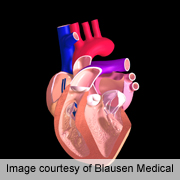
WEDNESDAY, June 20 (HealthDay News) — One in eight heart attack survivors experiences signs of post-traumatic stress disorder, the same condition that disables many combat veterans and assault victims, according to a new analysis.
And development of post-traumatic stress disorder (PTSD) symptoms doubles heart patients’ risk of a second heart attack or death within three years, researchers found.
“You find almost exactly a doubling of risk for recurrent heart attack or death from heart attack if they have PTSD at one month [after the original heart attack],” said Donald Edmondson, assistant professor of behavioral medicine at Columbia University Medical Center in New York City.
Common characteristics of PTSD include nightmares, avoidance behaviors, elevated blood pressure and rapid heart rate.
The study indicates that PTSD, an anxiety disorder brought on by trauma, “can occur from any life-threatening event,” Edmondson said.
“PTSD has become known as a combat disorder, which is a fundamental misunderstanding of PTSD,” he said.
For the study, Edmondson pooled the results of 24 published studies involving almost 2,400 heart patients. Overall, 12 percent of the patients displayed significant PTSD symptoms, and about 4 percent met the criteria for a full diagnosis of PTSD.
In addition, three studies that followed more than 600 patients with PTSD after a heart attack showed these patients had twice the risk of recurrent heart attacks or death.
The analysis is published online June 20 in the journal PLoS ONE.
In the studies, patients were asked about PTSD symptoms at least one month and up to 10 years after their heart attack. On average, patients were interviewed less than two years after.
Symptoms must last more than one month after the event before a formal PTSD diagnosis can be made, experts concur.
Dr. Marcia Slattery, director of the University of Wisconsin Anxiety Disorders Program, called the new analysis ”an important study.”
Cardiologists have long been aware that depression often occurs after heart attacks, she said. They may, however, be surprised at the how often instances of PTSD and PTSD symptoms were found by Edmondson, she said.
The key question, Slattery said, is: Who are the 12 percent displaying symptoms? Determining which risk factors predispose some patients to PTSD could help identify those likely to need assistance.
Simon Rego, director of psychology training at Montefiore Medical Center in New York City, said the new analysis sheds light on an area that hasn’t been studied extensively.
Experts know some patients recover on their own, he said. For others, the outlook isn’t that good.
“[For some], something interferes with the natural recovery process,” Rego said. “People who end up with the diagnosis tend to think the memories are as threatening as the event itself.”
As a result, they may adopt negative behaviors, such as avoiding anything that reminds them of the event. For those people, cognitive behavioral therapy — a structured and goal-oriented approach to therapy — can help them separate their memories of the event from the event itself, Rego said. In the process, they can resume a more normal lifestyle.
For heart attack patients, the take-home message is to pay attention to your symptoms, Edmondson said.
“If it’s a month after your heart attack and you still find you are not able to get on with life — you still are experiencing the event, having nightmares — then it is time to say something,” he said.
The U.S. National Institutes of Health funded the study.
More information
To learn more about PTSD, visit the National Institute of Mental Health.

